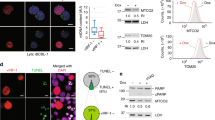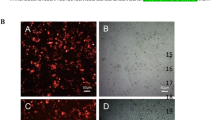Abstract
The herpes simplex virus type 1 (HSV-1) virion protein VP22 exhibits the remarkable property of intercellular trafficking whereby the protein spreads from the cell in which it is synthesized to many surrounding cells. In addition to having implications for protein trafficking mechanisms, this function of VP22 might be exploited to overcome a major hurdle in gene therapy, i.e., efficient delivery of genes and gene products. We show that chimeric polypeptides, consisting of VP22 linked to the entire p53 protein, retain their ability to spread between cells and accumulate in recipient cell nuclei. Furthermore the p53–VP22 chimeric protein efficiently induces apoptosis in p53 negative human osteosarcoma cells resulting in a widespread cytotoxic effect. The intercellular delivery of functional p53–VP22 fusion protein is likely to prove beneficial in therapeutic strategies based on restoration of p53 function. These results, demonstrating intracellular transport of large functional proteins, indicate that VP22 delivery may have applications in gene therapy.
This is a preview of subscription content, access via your institution
Access options
Subscribe to this journal
Receive 12 print issues and online access
$209.00 per year
only $17.42 per issue
Buy this article
- Purchase on Springer Link
- Instant access to full article PDF
Prices may be subject to local taxes which are calculated during checkout
Similar content being viewed by others
References
Verma, I. and Somia, N. 1997. Gene therapy-problems, promises and prospects. Nature 389: 239–242.
Elliott, G. and O'Hare, P. 1997. Intercellular trafficking and protein delivery by a herpesvirus structural protein. Cell 88: 223–233.
Levine, A.J. 1997. P53, the cellular gatekeeper for growth and division. Cell 88: 323–331.
Diller, L., Kassel, J., Nelson, C.E., Gryka, M.A., Litwak, G., Gebhardt, M. et al. 1990. P53 functions as a cell cycle control protein in osteosarcomas. Mol. Cell Biol. 10: 5772–5781.
Pientenpol, J.A. 1994. Sequence specific transcriptional transactivation is essential for growth suppression by p53. Proc. Natl. Acad. Sci. USA 91: 1998–2002.
Baker, S.J., Markowitz, S., Fearon, E.R., Willson, J.K.V. and Vogelstein, B. 1990. Suppression of human colorectal carcinoma cell growth by wild type p53. Science 249: 912–915.
Hamada, K., Alemany, R., Zhang, W.-W., Hittelman, W.N., Lotan, R., Roth, J.A. and Mitchell, M.F. 1996. Adenovirus-mediated transfer of a wild type p53 gene and induction of apoptosis in cervical cancer. Cancer Res. 56: 3047–3054.
Nielsen, L.L., Dell, J., Maxwell, E., Armstrong, L., Maneval, D. and Catino, J.J. 1997. Efficacy of p53 adenovirus mediated gene therapy against human breast cancer xenografts. Cancer Gene Ther. 4: 129–138.
Xu, M., Kumar, X.M., Srinivas, S., Detolla, L.J., Yu, S.F., Stass, S.A. and Mixson, A.J. 1997. Parental gene therapy with p53 inhibits human breast cancer tumors in vivo through a bystander effect without evidence of toxicity. Hum. Gene Ther. 8: 177–185.
Roth, J.A. 1996. Retrovirus-mediated wild type p53 gene transfer to tumors of patients with lung cancer. Nat. Med. 2: 985–991.
Cai, D.W. 1993. Stable expression of the wild type p53 gene in human lung cancer cells after retrovirus-mediated gene transfer. Hum. Gene Ther. 4: 617–624.
Sandig, V, Brand, K., Herwig, S., Lukas, J., Bartek, J. and Strauss, S. 1997. Adenovirally transferred p16 and p53 genes cooperate to induce apoptotic tumor death. Nat. Med. 3: 313–319.
Qazilbash, M.H., Xiao, X., Seth, P., Cowan, K.H. and Walsh, C.E. 1997. Cancer gene therapy using a novel adeno-associated virus vector expressing human wild type p53. Gene Ther. 4: 675–682.
Mesnil, M., Piccoli, C., Tiraby, G., Willecke, K. and Yamasaki, H. 1996. Bystander killing of cancer cells by herpes simplex virus thymidine kinase gene is mediated by connexins. Proc. Natl. Acad. Sci. USA 93: 1831–1835.
Elliott, G.D. and Meredith, D. 1994. The herpes simplex virus type 1 tegument protein VP22 is encoded by gene UL49. J. Gen. Virol. 73: 723–726.
Leslie, J., Rixon, F., McLauchlan, J. 1997. Overexpression of the herpes simplex virus type 1 tegument protein VP22 increases its incorporation into virus particles. Virology 220: 60–68.
McLauchlan, J., Liefkins, K. and Stow, N.D. 1994. The herpes simplex virus type 1 UL37 gene product is a component of virus particles. J. Gen. Virol. 75: 2047–2052.
Harlow, E., Crawford, L.V., Pirn, D.C. and Williamson, N.M. 1981. Monoclonal antibodies specific for simian virus 40 tumor antigens. J. Virol. 39: 861–869.
Author information
Authors and Affiliations
Corresponding author
Rights and permissions
About this article
Cite this article
Phelan, A., Elliott, G. & O'Hare, P. Intercellular delivery of functional p53 by the herpesvirus protein VP22. Nat Biotechnol 16, 440–443 (1998). https://doi.org/10.1038/nbt0598-440
Received:
Accepted:
Issue Date:
DOI: https://doi.org/10.1038/nbt0598-440
This article is cited by
-
Cellular protection from H2O2 toxicity by Fv-Hsp70: protection via catalase and gamma-glutamyl-cysteine synthase
Cell Stress and Chaperones (2023)
-
T cells loaded with magnetic nanoparticles are retained in peripheral lymph nodes by the application of a magnetic field
Journal of Nanobiotechnology (2019)
-
Cell-penetrating artificial mitochondria-targeting peptide-conjugated metallothionein 1A alleviates mitochondrial damage in Parkinson’s disease models
Experimental & Molecular Medicine (2018)
-
VP22 and cytosine deaminase fusion gene modified tissue-engineered neural stem cells for glioma therapy
Journal of Cancer Research and Clinical Oncology (2013)
-
VP22 enhances the expression of glucocerebrosidase in human Gaucher II fibroblast cells mediated by lentiviral vectors
Clinical and Experimental Medicine (2012)



